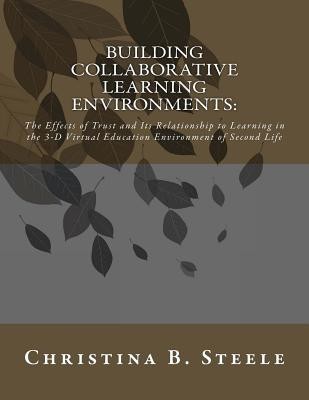
- We will send in 10–14 business days.
- Author: Christina B Steele
- Publisher: Steele Shark Press
- ISBN-10: 0615861261
- ISBN-13: 9780615861265
- Format: 21.6 x 27.9 x 0.8 cm, softcover
- Language: English
- SAVE -10% with code: EXTRA
Reviews
Description
3-D immersive virtual worlds as exemplified by Second Life are used for entertainment, business, and education purposes, and to facilitate a wide variety of activities online. Meanwhile, researchers also see the significant impact of such environments on distance learning. However, most research in this area has focused on the use of virtual worlds as a tool for enhancing engagement but there is a lack of research on the how trust affects learning in the virtual world. Managing teams of students and faculty in this context requires a deeper understanding of people, processes, technology, and the role of trust in virtual worlds compared to face-to-face interactions. Researchers still have little knowledge of the value of these virtual worlds as educational platforms. This dissertation, therefore attempts to fill a gap by exploring, in particular, the potential learning benefits enabled by the educator building trust in these unique environments. The research methodology is based on Creswell's qualitative design, and Boje's storytelling construct is used to explore trust in virtual environments used for learning. An extensive review of published research led to the discovery of learning affordances such as the facilitation of tasks to enhance trust and improve the contextualization of learning, compared to tasks made possible by 2-D alternatives. This study addresses how the facilitator creates trust and an effective collaborative learning group. This study concludes that a narrative is a web of living stories that binds learning communities together. The current study also contends that the continued investment in 3-D virtual worlds for educational purposes should be considered, contingent upon investigation into the interpersonal relationships, which are present in virtual worlds and their use for learning.
- Author: Christina B Steele
- Publisher: Steele Shark Press
- ISBN-10: 0615861261
- ISBN-13: 9780615861265
- Format: 21.6 x 27.9 x 0.8 cm, softcover
- Language: English English
3-D immersive virtual worlds as exemplified by Second Life are used for entertainment, business, and education purposes, and to facilitate a wide variety of activities online. Meanwhile, researchers also see the significant impact of such environments on distance learning. However, most research in this area has focused on the use of virtual worlds as a tool for enhancing engagement but there is a lack of research on the how trust affects learning in the virtual world. Managing teams of students and faculty in this context requires a deeper understanding of people, processes, technology, and the role of trust in virtual worlds compared to face-to-face interactions. Researchers still have little knowledge of the value of these virtual worlds as educational platforms. This dissertation, therefore attempts to fill a gap by exploring, in particular, the potential learning benefits enabled by the educator building trust in these unique environments. The research methodology is based on Creswell's qualitative design, and Boje's storytelling construct is used to explore trust in virtual environments used for learning. An extensive review of published research led to the discovery of learning affordances such as the facilitation of tasks to enhance trust and improve the contextualization of learning, compared to tasks made possible by 2-D alternatives. This study addresses how the facilitator creates trust and an effective collaborative learning group. This study concludes that a narrative is a web of living stories that binds learning communities together. The current study also contends that the continued investment in 3-D virtual worlds for educational purposes should be considered, contingent upon investigation into the interpersonal relationships, which are present in virtual worlds and their use for learning.


Reviews